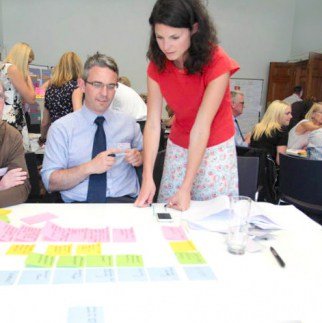How Open Policy Making is bringing design to the heart of government

Rachel Pascual, a former member of the UK Government’s Open Policy Making team (OPM), shares her experience of discovering design and how the OPM team are finding practical ways to bring new tools to the 19,000 policymakers across UK central government.
Open Policy Making is part of a growing movement in UK Central Government to improve policymaking. The major driver for this is the Civil Service Reform Plan (2012) which aims to tie policy decisions more closely to implementation and to bring outside expertise into the UK Civil Service. Following the Plan a new Policy Lab was created alongside the Open Policy Making team, to work with central government departments on policy challenges using design.
We’re excited to be sharing the first iteration of the Open Policy Making toolkit, launched in April 2015, to guide policymakers in a range of new techniques – including design. The team are now seeking feedback on the toolkit and we’d encourage you to explore the excellent resources and submit comments.
The role of design thinking in Open Policy Making
Open Policy Making is about better policymaking: being open to new ideas, new ways of working, new insights, evidence and experts. We work collaboratively with colleagues both within and outside the civil service to encourage open approaches to policymaking.
Sir Jeremy Heywood, Head of the UK Civil Service, explains the importance of Open Policy Making
Design thinking was new to me when I joined the team over a year ago. Until then, I viewed design as basically about making things look nice. But others in the team were getting excited about the potential for design to transform policymaking. It is widely accepted that policymakers in government must get better at putting the user first: starting with their needs rather than trying to fit them into existing structures. I began to appreciate the value of design in achieving that perspective by using tools like personas, customer journeys and service mapping.
So with the me and the Open Policy Making team convinced, the question became how to introduce it to the 19,000 policymakers across Government in a meaningful way!
Raising awareness
If I didn’t know about design thinking, it seemed likely I wasn’t the only one. Part of our core role in the Open Policy Making team is to demystify some of the tools and techniques we talk about – things like digital tools, data science and design thinking.
At our January Open Policy Making conference we organised hands-on sessions where senior leaders in the Civil Service could learn about things like ethnographic insight tools (with Mary Cook, uscreates), user journeys (with Colum Lowe, Design Council) and the value of prototyping (with Alice Casey, Nesta).
We continue to highlight the value of design. That could be by sharing examples of how design thinking is already being used in policy teams across Government, like with the Department for International Development’s Amplify project. Or through things like our SPRINT: policy event in May where we teamed up with the Government Digital Service (GDS) to talk all things digital, data and design.
Demonstrating by doing: Policy Lab
We know that the best way to learn is by doing, so as well as sharing good practice, we wanted to test some of these new techniques for ourselves.
The Policy Lab is an experiment at the heart of Government where policy teams can develop the skills and knowledge to make policy in a more open, digital and user-centred way. Three demonstrator projects with the Home Ministry of Justice and HMRC are underway. Through practical projects like this and one-off experiments the Policy Lab team are testing, refining and evaluating new and emergent ways of working. Along the way they are sharing their learning with colleagues both within and outside of the Civil Service.
Design is too important to be left to designers
In October 2014 the Policy Lab and Open Policy Making teams organised eight simultaneous ‘open ideas’ days as part of the Northern Futures initiative. The Deputy Prime Minister’s team had asked us to help them reach more people in the north of England and generate ideas in advance of their November Summit.
At the open ideas day in Sheffield I saw first-hand how design methods could be used to rapidly generate ideas and share them amongst people from a range of backgrounds. Drawing and using Lego doesn’t always come naturally to us civil servants, but I was struck by how those techniques helped quickly visualise and share ideas in the way that the most beautifully drafted briefing never can.
Nick Clegg, former UK Deputy Prime Minister, introduces the Open Ideas Day
Demystifying design
As Dr Andrea Siodmok, Head of the Policy Lab is fond of quoting, ‘design is too important to be left to designers’. Civil servants have a huge appetite to learn about different techniques that can help to achieve better outcomes for users.
One of the key barriers that remains is confidence. That takes time to build, but we hope that by sharing learning and giving people the space to try new things, we can help that happen.
Through thought leadership and practical projects we hope to explore not only why design thinking can be useful in a central and local government context, but crucially how we can apply it in our work.

